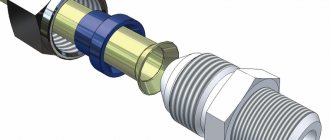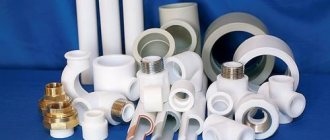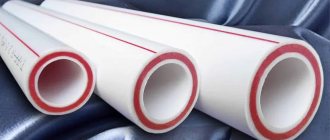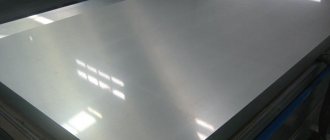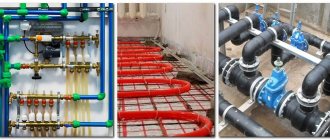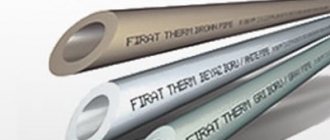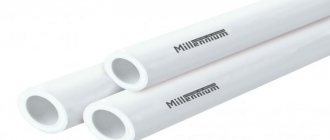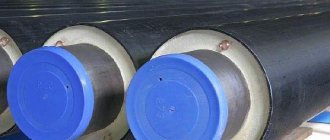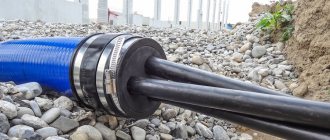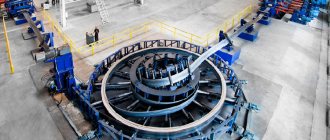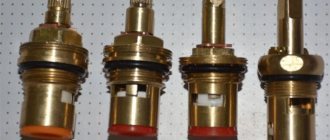Round pipes are an ideal option for transporting liquid and gaseous media over any distance. This form of pipeline resists pressure from any direction equally well. These products are manufactured using various technologies, the features of which, in fact, determine their specific properties. The most popular ones include electric-welded pipes (long-seam pipes that meet the requirements of GOST 10704 91.
GOST 10704-91 regulates the production of straight-seam and spiral-seam pipes
Classification and types
Steel pipes are divided into types:
- Seamless. They are a one-piece construction without a seam and are characterized as thick-walled.
- Straight-seam. They are produced by welding steel strips using high-frequency equipment. They are produced from low-alloy and carbon steel. Compared to the first ones, they are thin-walled.
Straight-seam products can vary in length and be measured or unmeasured. All these metal products differ not only in their properties, but also in their manufacturing technology. They are sold as rolled products and are black in color, but can be coated with zinc. Galvanized products are more expensive.
Electric welded products can be of various profiles : oval, round, square or rectangular. All of them are produced according to the requirements of the state standard. Also, products can be of different quality.
During manufacturing, standardization for mechanical properties is marked with the letter “A”, for chemical composition – with the letter “B”. Options with normalization of both indicators are designated by the letter “B”. Products with normalized test hydraulic pressure are marked “D”.
Square and rectangular products can be heat treated. They are also produced hot-reduced and without heat treatment during production. The diameter and length of the products will depend on their area of application. The accuracy of the outer diameter of the ends can be increased or normal.
Depending on the characteristics of the seam, products are divided into two types:
- Spiral welded pipes. On such products the seam is made along a helical line.
- Straight-seam pipes. In such products, the seam is made parallel to their axis.
The straight-seam manufacturing method is popular due to its availability and cost-effectiveness. This method is used for the manufacture of products with large diameters.
Metal for production is processed by cold or hot deformation. The hot deformation method is expensive, which makes it unprofitable. Because of this, the cold deformation method is used in industry.
Advantages
Seamless and straight-seam products have the following advantages:
- Anti-corrosion properties.
- Wide range of applications.
- Affordability.
- Resistance to temperature fluctuations.
Application area
Such products are considered to be universal due to the fact that their scope is multifaceted. They are most often used:
- In the automotive industry.
- In the motor industry.
- In the textile industry.
- In carriage building and mechanical engineering.
- When equipping the agricultural industry.
- As equipment in furniture factories.
- In various construction fields.
- In the manufacture of structures for children's playgrounds.
- In the manufacture of metal structures, for example, frames for fences.
- In the shipbuilding industry.
- In the aviation industry.
These products have received a wide range of applications due to their ability to withstand heavy loads. Modern technologies and welding equipment provide welded products with strength equal to their seamless counterparts. They are not inferior to such analogs in terms of quality and performance properties.
Such products can be used for the construction of railings. Support structures for television and radio towers are assembled from steel products. No matter what modern people do, steel pipe is an indispensable element in various fields of industry.
Features and Specifications
Technical features are described by standard 91 GOST. It was developed in 1991. Since then, experts have repeatedly changed it, introducing relevant amendments.
Part of the drawing from the core pipe
Rolled metal of round cross-section is excellent for transporting or distilling gaseous and liquid media over the most remote distances.
Important!
The basic characteristic of this product is resistance to bending. The ability to twist is completely absent. This determined the use of the product in particularly difficult conditions.
The high resistance to mechanical and chemical loads of ESP models is determined by the peculiarities of the production technology. At the same time, a product with DN50 weighs relatively little, which allows it to be used in a wide variety of projects, for example, in the arrangement of water supply, heating, gas supply systems in houses, the construction of metal structures, the production of garden and interior furniture, in mechanical engineering, etc.
The market offers straight-seam and spiral-seam products. Electric-welded pipe options with a straight seam are more in demand.
Electric-welded straight-seam samples are usually produced with a small diameter. Spiral seams always have large dimensions around the circumference. In addition, models with a longitudinal seam are universal. They have the widest range of applications and are used when laying gas systems, water supply systems, in the areas of automobile and tractor construction, when arranging fences, etc.
According to the current regulations, products are produced in measured or unmeasured lengths.
Standard requirements:
- Measured: diameter varies from 16 to 426 mm with length from 5 m to 12 m.
- If the requirements of GOST are violated in terms of regulated (permissible) dimensions, then the product is already considered oversized. In this case, so-called trimmings (from 2 to 5 m) are supplied for sale.
Pipe ∅530×9 K 52 welded
High strength and long service life guarantee the impeccable quality of any object in the design of which this rolled metal product is present.
Materials for making pipes
Various steel grades are used for production . Low alloy and carbon steels are the most in demand in this area. Such steel alloys are characterized by strength and hardness. Another advantage is their reasonable price. The disadvantages of this alloy include low wear resistance and heat resistance.
Alloy steel has clear advantages. Chromium and nickel included in the alloy make the metal strong and hard, improve hardenability and ductility. This makes it impact resistant and corrosion resistant. Adding manganese to the composition will make the steel alloy wear-resistant and increase strength, but its ductility will decrease.
Criteria for selecting electric welded pipes
One of the important characteristics when choosing electric welded products is their dimension .
For many buyers, important criteria are the technical characteristics and composition of the metal from which the products were made. But still, the most important characteristics are indicators of dimensionality or non-dimensionality. Steel products can be produced in production of any length if the customer requires a product for a special project. Also, along with the main characteristics, it is important to provide for the type of medium for further transportation (gaseous or liquid) and the degree of its influence on the metal alloy.
In order to purchase a quality product, it is better to turn to manufacturers who have been working for several years and have good recommendations. Only large enterprises focused on long-term cooperation have high-quality equipment and qualified specialists.
Why are electric welded pipes needed?
Welded pipes are universal in their application. Pipelines made from electric-welded steel pipes are found in almost every industry where the movement of liquids or gases is necessary to one degree or another: in the oil industry, when creating heating or water supply lines, gas transmission systems of any capacity, etc.
In addition to being used directly in industry, such pipes are used as an auxiliary material. For example, when building fences or fences, fences and barriers.
Separately, it should be noted the use of welded pipes in the production of sports equipment. After all, it was the use of high-quality profile or round cross-section products that made it possible to create safe racks, benches and exercise machines that can withstand large weights with a reserve, and therefore ensure the safety of the athlete’s health even if the weight is not held or a shock load occurs.
Classification of electric welded pipes
These products can be divided according to several criteria, in particular, by the presence or absence of a weld on the pipe.
Advantages of electric-welded pipes without a seam (seamless):
- can work in conditions with greater pressure than analogues;
- suitable for transporting chemically active, aggressive, toxic liquids or gases (subject to the correct selection of the cross-section and internal coating of the product);
- characterized by a longer service life (subject to the necessary conditions);
- easier to manufacture (do not require rolling and subsequent welding operations).
According to the production method, a seamless pipe can be:
- hot-deformed (rolled or pressed);
- cold-deformed (heat- or cold-drawn, heat- or cold-rolled).
Often, however, it is necessary for the pipe to have stiffening ribs that provide the strength necessary for construction. In this case, profile pipes with a seam are used.
Based on the type of seam, such products are divided into:
- longitudinally welded pipes - the seam is made in a continuous straight line (parallel welding);
- spiral welded pipes - welding is called screw welding and runs in a spiral, covering the entire product.
Easier to manufacture, more versatile and cheaper are electric-welded straight-seam pipes, which have become the most widespread. In addition, straight-seam pipes are presented on the market in any size, and similar products with a spiral seam are only of larger sections (read: “Long-way electric-welded steel pipes - norms, standards, scope of use”).
Straight-seam pipes according to the manufacturing method are divided into:
- hot-deformed - produced with thicker walls, which is why they are not suitable for every technological scheme; are more expensive;
- cold-formed - easier to manufacture and therefore cheaper; the most popular product.
Classification
GOST 10704-91 describes the range of electric-welded products of round cross-section.
Steel riser 426 mm GOST 10705-80
It identifies four groups:
- "A". Products designed for extreme mechanical loads.
- "B". Products intended for use in conditions of interaction with aggressive chemical substances.
- "IN". Products that combine the properties of the two previous groups: A+B.
- "D". Products intended for use under high pressure conditions. Their task is to resist pressure (internal and external). Manufactured using test hydraulic pressure.
Experts divide all rolled metal products of this category into two large groups - according to the presence or absence of a seam:
- Seamless . These products have a higher strength coefficient. They are highly resistant to any influence, both internal and external. For their production, an all-metal template (blank) is used. These products are highly valued in the market, but their cost is quite high.
- Suture (electric welded). Their production is less labor-intensive, so the price of 1m (PM) is an order of magnitude lower.
Electric welded models, in turn, are classified as follows:
- Straight-seam. The seam is distributed along the entire length.
- Spiral seam. The seam has the shape of a spiral. The product is particularly resistant to breaking loads.
Classification by length
Unmeasured (diameter, mm):
- less than 30: not less than 2 m;
- from 30 to 70: not less than 3 m;
- from 70 to 152: at least 5 m.
In case of production necessity and at the request of the consumer, samples with a diameter of over 152 mm from groups “A” and “B”, according to GOST 10705 , are produced with a length of 10 m. It is also possible to produce products of any group with a diameter of up to 70 mm. Their working length will be at least 4 m.
Dimensional (diameter, mm):
- less than 70: models range from 5 to 9 m;
- from 70 to 219: models range from 6 to 9m;
- from 219 to 426: models vary from 10 to 12 m.
Multiple length:
The multiplicity must be at least 250 mm. In addition, it should not exceed the lower limit provided for measured products. An allowance of 5 mm is allowed for each cut. The exception is situations when the allowance is specified separately. It comes in every multiple.
Samples of multiple and measured lengths are produced in two accuracy classes provided for length:
- I class. This involves deburring and trimming the ends.
- II class. – Trimming and deburring are not provided.
76x3.5; 76x4.0 electric/welded galvanized
This is interesting: Rolled sheets
Production of electric welded steel pipes
The production of pipes, as products of complex geometry and a wide range of purposes, is a rather long and complex process. Products are made from strips - pre-made steel strips cut from a sheet of hot or cold rolled steel with a ligature.
The manufacturing process of welded pipes includes the following stages:
- Unwinding a sheet of steel.
- Longitudinal cutting.
- Editing cut strips.
- Trimming the end of the strip.
- Electric welding of steel strips.
- Rolling of the future product on a molding mill.
- High frequency welding.
- Removing excess material from the product and cooling.
- Rolling on a sizing mill.
- Flaw detection.
- Cutting pipes to production sizes.
- Trimming.
- Heat treatment.
- Passing the straightening mill, giving the final shape.
- Visual inspection and hydrotesting.
- Packaging of finished products.
The most interesting part of production is welding. To do this, a high voltage current is passed through the workpiece; As a result, the material heats up and melts, after which it is given the desired shape.
Manufacturing methods
Welded pipes are made using three technologies:
- Furnace welding. The blanks, called strips, are heated in a tunnel furnace to 1300˚ After leaving it, the edges are blown with hot air, raising their temperature to 1400˚C while simultaneously blowing off scale. Then the workpiece is processed on a forming and welding mill, giving it the desired shape. After the secondary blowing of the edges with hot air, they are welded together. The workpiece passes through the oven again, then the seam is pressed using forming rollers to improve quality. Products produced using this technology are classified as hot-deformed.
- Electric welding. This is the most common method, as it allows you to make thin-walled products of large diameters. The seams are made using submerged arc welding. Pipe blanks from cold strips are produced at a rolling mill using the roll forming method. Hemispheres for straight-seam types of large diameter are made by compression molding. Spiral seam blanks are produced on roller-mandrel or bushing mills. After welding the edges, a straight or spiral-shaped seam is formed on the surface. After it is cleaned and cooled with water, the workpiece is transferred to a sizing mill, where the diameter is adjusted along the entire length. Then the quality of the seam is checked visually and ultrasound, after which hydrotests of its strength are carried out. If, after another ultrasound scan, no defects are found, the electric-welded pipes are sent to the finished product warehouse.
- Welding in an inert gas environment. This technology produces options from alloy and stainless steel. During conventional welding, the quality of the weld decreases due to the carbidization of alloying additives that occurs when interacting with atmospheric oxygen. To eliminate this phenomenon, the welding site is protected with argon, helium, and carbon dioxide. The weld is created by melting with an electric arc a filler wire made of the same material as the pipe. Welding is carried out with a non-consumable tungsten electrode. Products created using this and previous technology are classified as cold-formable.
Dimensions of electric welded pipes
Another important parameter of a product is its size. Accordingly, pipes of measured and unmeasured length are distinguished.
Products of unmeasured length include:
- pipes with a diameter of up to 30 mm and a length of 2 m;
- pipes with corresponding indicators 30-70 mm and 3 m;
- products with a diameter of 70-152 mm and a length of 4 m;
- pipes with a diameter of more than 152 mm and a length of more than 5 m.
Relevant characteristics of measuring tubes:
- diameter up to 70 mm – length 5-9 m;
- 70-219 mm – 6-9 m;
- 219-426 mm – 10-12 m.
You can buy from us
| Name | Diameter (mm) | Wall thickness (mm) | Length |
| Electrical pipe | 57 | 3,5 | 10.5m |
| Electrical pipe | 57 | 3,5 | 10m |
| Electrical pipe | 76 | 3,5 | 10.5m |
| Electrical pipe | 76 | 3,5 | 5.25m |
| Electrical pipe | 89 | 3,5 | 10.5m |
| Electrical pipe | 108 | 3,5 | 10.0m |
| Electrical pipe | 114 | 4 | 12m |
| Electrical pipe | 127 | 4 | 11.7m |
| Electrical pipe | 127 | 4 | 12m |
| Electrical pipe | 127 | 4 | 5.85m |
| Electrical pipe | 133 | 4 | 12m |
| Electrical pipe | 159 | 4 | 12m |
| Electrical pipe | 159 | 4 | 6m |
| Electrical pipe | 219 | 5 | 11.7m |
Other Welded Pipe Selection Options
In addition to the above characteristics (presence or absence of a weld, its type, dimension of the product), pipes should also be selected based on the planned location and conditions of use.
For example, in conditions of increased corrosion hazard in the external environment, preference should be given to pipes made of high-quality corrosion-resistant steel. They cost more than conventional pipes, but their use reduces the risk of breakdown and subsequent repair of the pipeline (and therefore downtime with loss of money) and a threat to the health and life of operating personnel.
If you plan to move aggressive media through a pipe, you again need to use pipes made of a steel grade appropriate for the environment or products with special liners.
In general, it should be noted that currently the industrial production of electric welded pipes is not a problem. The production of such products is carried out by both large-scale enterprises and small firms. The quality of the finished product and its price ultimately primarily depend on the consumables and equipment used.
On the market you can find products of the required length and profile geometry, with any type of weld or lack thereof. There is also a fairly wide range of steel grades from which electric-welded pipes are made.
Therefore, with today’s opportunity to choose, what comes first is not the question of how to make or where to get the right pipe, but the problem of correct, conscientious installation of the product and subsequent operation.
After all, compliance with safety precautions at every stage of working with welded pipes is a guarantee of the safety of the technological process and long-term uninterrupted operation of the pipeline.
Scope of application of electric-welded pipes
The quality for which electric-welded pipe is especially valued is its exceptional versatility of use. This primarily concerns round products, which are successfully used by industrial enterprises and construction organizations, as well as in the installation of pipelines, furniture production and the creation of interiors for modern residential and commercial premises. In addition, electric welded pipe is often used as a consumable material for the production of various products.
How widespread pipes of this type are can be judged by the fact that they are found almost everywhere: fencing of buildings and territories, stair railings, awnings, canopies and public transport stops, street benches, etc. The high quality of steel pipes is evident. straight-seam electric welded, evidenced by the fact that they are successfully used for the installation of pipelines through which chemically aggressive liquids and media heated to high temperatures are transported.
Range and sizes
The assortment is determined by GOST 10704-91. For technical specifications, GOST 10705 is relevant. Steel grades 2PS or 3PS are used in production.
Dimensions established by GOST 10704-91
Compliance of a straight-seam pipe with GOST must be confirmed by a quality certificate.
Classification of electric welded pipes by seam type
Electric-welded pipes, depending on the characteristics of the seam, can be of two types:
- with a weld that is parallel to their axis (since the seams of such pipes are located in a straight line, they received the corresponding name - straight-seam electric-welded steel pipes);
- with a weld made along a helical line (such pipes are called spiral welded).
Straight-seam electric welded pipe
Electric-welded products of the straight-seam type have become most widespread due to their ease of manufacture (and, accordingly, cost-effectiveness). Spiral welds are typically used to produce large-diameter pipes.
Pipe products with any type of seams are divided according to the method of processing the material used for their manufacture. So, depending on this parameter, electric welded pipes are divided into:
- cold-deformed, that is, made of sheet metal obtained by cold deformation;
- hot-deformed, for the manufacture of which metal sheets are used, additionally subjected to hot deformation.
It should be noted that hot-formed products are more expensive, which makes their use less profitable.
Spiral welded electric welded steel pipe
Types and features of welded pipes
Straight-seam types are made from a metal sheet or tape rolled around the circumference, followed by welding of the edges. The connection line runs along the axis. Since the width of the sheets is limited, products of large diameter are welded from two hemispheres, placing seams on both sides.
Straight seam welded pipe
For the production of spiral seam varieties, long steel tape in rolls is used. The welding line runs along the outer surface in the form of a spiral. This method makes it possible to produce products with a diameter of up to 2.5 m on one rolling mill from material of uniform width. This technology produces welded pipes with a diameter to wall thickness ratio of more than 100.
Spiral welded pipe
To produce a spiral type, you do not need the complex equipment used in the production of straight-seam pipes. Among the advantages, it is noted that the spiral shape of the seam does not allow the formation of a long longitudinal crack upon rupture. However, due to the increased length of the seam, the consumption of materials for welding increases.
Production technology
The technological process by which electric-welded pipes are manufactured consists of a number of operations. It is quite complex, labor-intensive and time-consuming. In order for an electric-welded pipe to acquire its finished appearance, it is rolled from a strip of alloy steel (strip), which was previously produced by cold or hot deformation.
To produce high-quality and reliable pipes of different diameters, radio frequency welding is mainly used, which allows, among other things, to carry out the process of joining metal at a fairly high speed. With this welding method, high voltage currents are passed through a pre-rolled workpiece, which contributes to the rapid heating of its edges. In order for a reliable weld to form at the site of the heated and molten edges of the workpiece, they are pressed against each other under great pressure. In order to obtain a blank for an electric-welded pipe of the required diameter from a steel strip (strip), special crimping machines are used.
This technology, which uses specialized enterprises to produce straight-seam and spiral-welded electric-welded steel pipes, allows not only to obtain high-quality and reliable products, but also to provide them with an attractive appearance (the weld seam on such products is almost invisible).
Technological process for the production of welded pipes
Manufacturing technology and production
The manufacturing process is strictly regulated. It includes several steps:
- Metal cutting. Special equipment makes it possible to cut strips of the same width.
- Editing stripes. The slightest roughness is eliminated thanks to horizontal rollers. The waviness of the material is thereby reduced to a minimum or eliminated altogether.
- Molding of the workpiece. Rolls are used again: vertical and horizontal. The goal of this step is to minimize the radius of the workpiece by bringing the edges closer together.
- High frequency seam welding. The task of this stage is to connect the edges of the workpiece. The edges are heated to the melting temperature and joined using special equipment.
- Treatment of external weld seam (burr removal).
- Calibration This operation allows you to achieve the desired geometric parameters. The sizing rolls are activated.
- Profiling. This step is only relevant for profiled samples.
- Cutting. Using a cutting machine, the product is cut into the required fragments.
12X18N10T (GOST 9941-81)
The technological cycle is completed by a system of measures aimed at identifying quality control. It includes: non-destructive testing of the weld, hydrotesting, flattening. Only after this the product receives a quality certificate. Without it, it is impossible to obtain a certificate of compliance with GOST.
Sometimes you hear the opinion that galvanized samples cannot be welded. The skeptics' arguments boil down to the fact that in this case it is difficult to guarantee tightness. However, welding work in this case is carried out at a high quality level.
They are completely identical to those practiced when working with ferrous metals. But special technological requirements are imposed on working with this particular material:
- Avoid overheating during welding. Otherwise, the zinc layer may begin to deteriorate.
- Carry out work in a room with good air circulation. In the absence of good ventilation, zinc vapor can have a negative impact on workers.
- Upon completion of welding, the seam is thoroughly cleaned. After the stripping process, a special coupling is installed in the center of the seam. It is boiled on both sides and painted when the temperature allows (after complete cooling).
The technology is relevant for the manufacture of products of any diameter. But if the diameter is increased, then a more complex coupling is used. It may consist of two or more parts.
Permissible deviations from dimensions and lengths
The production of such products requires maximum precision.
Deviations in length of multiple models are allowed:
- Accuracy class I: no more than +15 mm;
- Accuracy class II: +100 mm.
Maximum deviations in the length of measured products. Table No. 1
At the request of the consumer (customer), the ends of measured and multiple products of class II accuracy can be trimmed. This operation is performed either on one side only, or on both.
The deviation of the outer diameter from the nominal value should be as minimal as possible.
Limit deviations in outer diameter Table No. 2
Sometimes, at the request of the customer, a displacement in the outer diameter is allowed. These assumptions should not exceed the sum of the established deviations.
Deviations in wall thickness are allowed (external diameter, mm):
- up to 152: ±10%.
- from 152 to 1020: ±10%.
- from 1020: according to the Table.
Maximum deviations for wall thickness Table No. 3
| Maximum deviations for wall thickness Table No. 3 | Tolerance |
| 8–15 | Based on wall thickness ±10% |
| Over 15 | ±1.5 mm |
It is considered normal if there is a special agreement between the manufacturer and the customer allowing unilateral admission. It must match the wall thickness. But in general, the deviation should not exceed the sum of the tolerances indicated in Table No. 3.
Round welded (630x7.0mm)
As for curvature, the standard allows deviations of 1.5 mm (no more!) per 1 meter .
Important!
The strictness of the technologists’ requirements is explained by the fact that rolled steel is used, among other things, in the construction of oil and gas pipelines. The slightest deviation from the technology approved by the standard is fraught with the most unpredictable consequences.
Basic requirements for transportation, storage and packaging
Rolled metal retains its original qualities under almost any conditions. But thin-walled products (1.5 mm) must be stored in a dry warehouse. Moisture is detrimental to it. Thin-walled samples can also be stored in special boxes. In this case, a canopy is required.
Storage of thick-walled samples is allowed in open space. The main thing is that a special platform be prepared for them.
Electric welded products are shipped in batches. There are no special requirements for its packaging. But a prerequisite is to secure the shipment during transportation. This will ensure overall safety during transportation.
Transportation of products is carried out:
- covered large-capacity cargo carriers;
- gondola cars;
- open vehicles.
Important!
The basic condition for transportation is the possibility of vertical loading. As for unloading, it can only be done with crane equipment.
As a rule, welded metal products are stored in bundles. In most cases, one such bundle weighs 5 tons. If a minimum quantity is sold, then shipment of a bundle weighing 1 ton is allowed.
Sometimes shipment is carried out without packaging (bundles). This is explained by the need to increase the volume of the shipped batch. In addition, this method significantly saves time during unloading work directly on site.
Features of choosing electric welded pipes
All electric-welded pipes must be assessed not only by the basic technical characteristics and composition of the metal used, but also by another important parameter - dimensionality. This parameter characterizes the length of the finished product, which can be fixed (measured pipes) or be within a specified range (unmeasured pipe products). The industry standard provides for the following classification of pipes according to their length.
- with a pipe diameter of up to 30 mm, its length starts from two meters;
- diameter 30–70 mm – at least 3 meters;
- diameter 70–152 mm – at least 4 meters;
- diameter more than 152 mm - at least 5 meters.
- diameter up to 70 mm – 5–9 meters;
- diameter 70–219 mm – 6–9 meters;
- diameter 219–426 mm – 10–12 meters.
Electric-welded straight-seam thin-walled steel pipe
Meanwhile, electric-welded steel pipes (both straight-seam and spiral-seam) can be produced in any length, if this is previously agreed with the customer.
When choosing electric-welded pipes, it is equally important to take into account not only their main characteristics, but also the type of medium that will be transported through them (liquid or gaseous), as well as the degree of its aggression. These factors influence the choice of tubular products in terms of composition and, accordingly, the properties of the material that was used for their manufacture.
Electric-welded pipes, distinguished by their exceptional versatility, are most actively used to solve the following problems: transporting water, oil, gas and other media with varying degrees of aggressiveness, creating various structures in the construction industry. Since the most important requirement for building structures is their rigidity and strength, pipes of predominantly square cross-section are used in this area.
Electric-welded pipe with thermal insulation for hot water supply
Today, many enterprises are engaged in the production of electric welded pipes, which can be both large state industrial complexes and small private companies. However, no matter what enterprise produces such products, only qualified and experienced specialists working on modern equipment can ensure their high quality, tightness and reliability. It is also very important that at such enterprises all necessary safety measures are observed: welding, with which such pipes are produced, is a technological process of increased danger.
When choosing a supplier of electric-welded pipes, it is better to pay attention to large and already proven companies. Only such enterprises, equipped with modern equipment and technological equipment, as well as staffed with qualified specialists, are able to ensure not only the high quality of the products offered, but also their prompt delivery in the required volumes.
The difference between an electric-welded pipe and a water-gas pipe
What is the difference between an electric-welded pipe and a water-gas pipe (WGP)? Despite the similarity in appearance, these two products have many differences in various respects.
Standards for VGP and ES pipes
When manufacturing VGP pipes, the manufacturer is guided by state standard 3262-75. This document determines the size, shape, production technology, safety factor and other parameters of the product. The production of steel electric-welded pipes is carried out in accordance with GOST 10705-80 and GOST 10704-91. The batch labeling must indicate the regulatory document, and from this data it is possible to determine the purpose of the product.
GOST dictates more stringent dimensional requirements for the production of electric-welded pipes. According to standards, the wall thickness of ES products should not have an error of more than 10%. When manufacturing VGP pipes, deviations cannot exceed 15%.
Materials and technology
The most important difference between an electric-welded pipe and a water-gas pipe lies in the properties of the raw materials. For both types of products, structural steel of ordinary quality is used, but for VGP they choose carbon steel with the abbreviation marking “sp”, “ps”, “kp” (for example, St. 1ps, St. 3kp). Electric-welded pipes are made from hard steel that is resistant to deformation and stretching. Products of both categories are produced in two types: made of ferrous metal and galvanized. If an anti-corrosion coating for ES pipes is not always necessary, then for VGP pipes, which are mainly used for water supply installations, industrial galvanization is a great advantage.
The manufacturing technology of VGP and ES pipes is similar. The products are formed from sheet metal and the edges are welded outside and inside. Water and gas pipes have a reinforced weld . Production is carried out on automated lines, which allows us to produce high-quality products in large volumes in a fairly short period of time. Long-seam ES and VGP pipes have a large margin of safety, but cannot withstand deformation.
Typical dimensions and product characteristics
The difference between steel electric-welded and water-gas pipes lies in the size of the products. While the outer diameter may be the same, the wall thickness and bore diameter of the ES and VGP are different. The range of water and gas pipes is limited - these are products with a wall thickness of 2–5.5 mm and an outer diameter from 10 to 165 mm. Electric welded ones can be significantly larger in size than VGP. With steel thicknesses from 1 to 32 mm, ES pipes are manufactured with a diameter of up to 1,420 mm. These products are designed for a maximum pressure of no more than 3 MPa (with a cross-sectional diameter of up to 102 mm) and 6 MPa (with D more than 102 mm). Water and gas pipes can withstand pressure of no more than 2.4 MPa, reinforced pipes - up to 3 MPa.
Labeling and packaging
Typical VGP products are marked by the nominal diameter (internal diameter), and electric welded ones - by the size of the external thread. Labeling is a short designation of products where all important information is encrypted. At production, a batch of goods is marked, indicating on the label the name (VGP or electric-welded pipe), the main dimensions, what grade of steel they are made of, and compliance with a certain standard (GOST or TU).
To deliver the batch to the buyer, the pipes are packaged in a special waterproof material. It is recommended to store products in a dry, ventilated room, which is reliably protected from the penetration of precipitation and the formation of high humidity. These requirements apply to both ferrous metal products and galvanized pipes.
In production, batches weighing from 2 to 5 tons are formed. Each pack is tied in three places with steel tape (or wire). Each batch is accompanied by a tag indicating the type of product, material of manufacture, main dimensions and GOST.
Assembly method
The raw material for the production of straight-seam steel pipes is sheet metal of different thicknesses. In industrial conditions, machines cut it and form blanks of standard length. The seam is first welded from the outside (usually using induction welding), then the procedure is repeated from the inside, and then carefully cleaned. In the case of water and gas pipes, the length ranges from 4 to 12 meters.
All kinds of swelling, corrosion, burrs and cracks are not allowed on high-quality products. There may be small dents or scratches that do not affect the functionality of the pipe. After processing, the products are sent for the procedure of applying anti-corrosion protection - galvanizing. Manufacturers use different technologies: for example, hot and cold galvanizing.
Scope of application
Unlike VGP, electric-welded pipes are used everywhere - in construction, machine tool and mechanical engineering, agriculture, furniture production and other areas. Water and gas products have a narrower purpose. VGP pipes are used for laying pipelines for supplying drinking water and gas. Mainly used in the housing and communal services sector.
Advantages and disadvantages
Why, with the same strength indicators and dimensions, are water and gas pipes preferred to electric welded ones? There's a good reason for this. The fact is that VGP pipes, which are lighter and better protected from corrosion, have an undoubted advantage - they have an optimal internal diameter due to the small wall thickness. Electric-welded ones, with the same strength indicators and dimensions, have low throughput, since the area of the internal hole in such products is smaller.
In addition, galvanized VGP pipes are almost not susceptible to corrosion, which cannot be said about electric-welded ones made of ferrous metal. It should be noted that in an aggressive environment, steel products without zinc coating very quickly become unusable. The rate at which rust destroys metal is up to 1.2 mm per year. Therefore, it is undesirable to use ES products for transporting liquids and place them in places with high humidity (for example, in wet soils).
Scope of application of electric-welded pipes
The quality for which electric-welded pipe is especially valued is its exceptional versatility of use. This primarily concerns round products, which are successfully used by industrial enterprises and construction organizations, as well as in the installation of pipelines, furniture production and the creation of interiors for modern residential and commercial premises. In addition, electric welded pipe is often used as a consumable material for the production of various products.
How widespread pipes of this type are can be judged by the fact that they are found almost everywhere: fencing of buildings and territories, stair railings, awnings, canopies and public transport stops, street benches, etc. The high quality of steel pipes is evident. straight-seam electric welded, evidenced by the fact that they are successfully used for the installation of pipelines through which chemically aggressive liquids and media heated to high temperatures are transported.
About ESV galvanized
Among rolled metal products, galvanization occupies a special place. The scope of its application is extensive due to its special strength and reliability.
ESV 76.1×3 Polished
The operating principle of the galvanizing process is based on the fact that zinc oxidizes much faster than steel alloy. This eliminates the very possibility of oxidative processes on the surface of the final product.
It will no longer be exposed to aggressive environmental influences, no matter where it is used. Such products are completely immune to high moisture, chemical environments and mechanical stress.
This product retains its properties in the most difficult conditions:
- under heavy wind load;
- when exposed to chemicals;
- at high humidity;
- under difficult climatic conditions.
An example of a heating system for a private house
The advantages of galvanized metal are a high degree of protection against ruptures and the longest service life.
Classification of electric welded pipes by seam type
Electric-welded pipes, depending on the characteristics of the seam, can be of two types:
- with a weld that is parallel to their axis (since the seams of such pipes are located in a straight line, they received the corresponding name - straight-seam electric-welded steel pipes);
- with a weld made along a helical line (such pipes are called spiral welded).
Straight-seam electric welded pipe
Electric-welded products of the straight-seam type have become most widespread due to their ease of manufacture (and, accordingly, cost-effectiveness). Spiral welds are typically used to produce large-diameter pipes.
Pipe products with any type of seams are divided according to the method of processing the material used for their manufacture. So, depending on this parameter, electric welded pipes are divided into:
- cold-deformed, that is, made of sheet metal obtained by cold deformation;
- hot-deformed, for the manufacture of which metal sheets are used, additionally subjected to hot deformation.
It should be noted that hot-formed products are more expensive, which makes their use less profitable.
Spiral welded electric welded steel pipe
Requirements for the appearance of electric welded pipes.
Cracks, flaws, stains and fragments of sunsets are not allowed on products manufactured in accordance with regulations 10704-91. During heat treatment, the appearance of oxide films on the surface is permissible, while the presence of scale is strictly prohibited.
In cases where traces of erasure, small scratches, small nicks, ripples on the surface, and dents do not fall outside the regulated tolerances for the geometry of the pipe product and the dimensions of its wall, then they may be present in the finished product.
The weld seam and the area around the seam must be cleaned. In case of lack of penetration of the seam at the pipe, it is necessary to eliminate such a defect.
For product edges, offsets to wall thicknesses are allowed, but not more than ten%. For electric welded products with diameters over 159 mm, displacement is possible up to twenty percent relative to the wall size
According to regulation 10705, the presence of one transverse seam is allowed on straight-seam electric-welded products with a diameter of over 57 mm. By agreement with the buyer, the presence of one transverse seam is allowed on products d < 57 mm. If pre-heat-treated products have undergone welding repair work, then the treatment should be carried out a second time using a similar technique. External burr on the surface of the product must be completely removed. Thorough cleaning removes all burrs from the surface of the pipe. The pipes are cut at right angles.
Production technology
The technological process by which electric-welded pipes are manufactured consists of a number of operations. It is quite complex, labor-intensive and time-consuming. In order for an electric-welded pipe to acquire its finished appearance, it is rolled from a strip of alloy steel (strip), which was previously produced by cold or hot deformation.
To produce high-quality and reliable pipes of different diameters, radio frequency welding is mainly used, which allows, among other things, to carry out the process of joining metal at a fairly high speed. With this welding method, high voltage currents are passed through a pre-rolled workpiece, which contributes to the rapid heating of its edges. In order for a reliable weld to form at the site of the heated and molten edges of the workpiece, they are pressed against each other under great pressure. In order to obtain a blank for an electric-welded pipe of the required diameter from a steel strip (strip), special crimping machines are used.
This technology, which uses specialized enterprises to produce straight-seam and spiral-welded electric-welded steel pipes, allows not only to obtain high-quality and reliable products, but also to provide them with an attractive appearance (the weld seam on such products is almost invisible).
Technological process for the production of welded pipes
